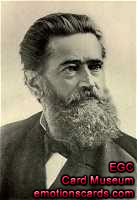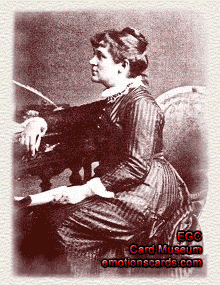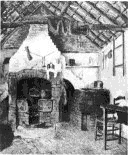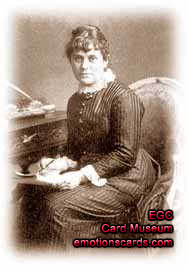The Goths were a Scandinavian tribe that was only one of several tribes who invaded the crumbling Roman empire. In 410, the city of Rome fell to plundering Northern Goths. They were prodigious woodworkers who made trade routes from the Baltic to the Black Sea.
"Gothic" was first used as a term of derision by Renaissance critics who scorned its lack of conformity to the standards of classic Greece and Rome. In effect, "Gothic" means barbarian.
Italian Gothic
"In Italy the true Gothic never made substantial inroads, though prominent exceptions like Milan's cathedral stand out.
http://www.buffaloah.com/a/archsty/gothic/index.html#Gothic
ECLECTIC STYLE - What is it?
Feb 20, 2004 - © Barbara Brice
What is Eclectic and what does it mean? One dictionary definition is: selecting individual elements from a variety of sources, systems or styles. Also, made up of or combining elements from a variety of sources. That all sounds interesting, but how does it relate to decorating. Well, as renters, we often do select or combine elements from a variety of sources. Especially if it is your first rental or your first time on your own. You many have inherited furnishings from family or leftover pieces from previous roommates. If you are a first time renter, you are most likely on a strict budget and one source might be shopping garage sales or thrift stores. Can it all be brought together and given a look of cohesion and style? Most definitely!
By using some or all of your pieces, you can accomplish an eclectic style that is uniquely your own. It doesn't matter if you prefer modern, country, contemporary or traditional; eclecticism can be applied successfully.
http://www.suite101.com/article.cfm/decorating_tenant/106575
A Victorian Sentiment offers an untraditional, relaxing, therapeutic three-hour Body Treatment for the discerning individual. http://www.avictoriansentiment.com/
Ornate Gate
Louis Prang
Believe it or not, the celebration of Christmas was once banned in Boston. It seems the Puritans considered it an invention of the devil. Although the law banning Christmas was repealed in 1681, it was not proclaimed a legal holiday here until 1856. This was the same year that Louis Prang, a German immigrant from Breslau Germany, came to America. He later became known as the father of the American Christmas card.
 PRANG, Louis (1824-1909) was born in Breslau of a French Huguenot father and German mother, and learned to dye print calico in his father's shop. After traveling as a journeyman in Europe, he went to the United States in 1850, a refugee of the revolutionary period. He came well trained as a lithographer and settled in Boston, where he started as a wood-engraver. He also became a lithographer, color-printer and publisher. Soon after the Civil War he began printing chromo lithographs; and during the 1870's he began to issue color reproductions of famous paintings.
PRANG, Louis (1824-1909) was born in Breslau of a French Huguenot father and German mother, and learned to dye print calico in his father's shop. After traveling as a journeyman in Europe, he went to the United States in 1850, a refugee of the revolutionary period. He came well trained as a lithographer and settled in Boston, where he started as a wood-engraver. He also became a lithographer, color-printer and publisher. Soon after the Civil War he began printing chromo lithographs; and during the 1870's he began to issue color reproductions of famous paintings.He was a writer on many subjects. He wrote the "Prang Method of Art Instruction" and the "Prang Standards of Color." He is remembered for "Prang's Natural History Series," published in 1873, and "Prang's Aids for Objective Teaching," which appeared in 1877, and both had a marked effect on the teaching of art throughout the United States. In 1882, the pioneer of American lithographing organized the Prang Educational Company to publish drawing books for schools, and Prang's water colors remained standard classroom equipment for many years. Sylvester Koehler, the son of a Leipzig artist, who was brought to the United States as a twelve-year old boy in 1849, became technical manager of Prang and Company in 1868, one of the founders of the American Art Review, and curator of the Boston Museum of Fine Arts. http://www.emotionscards.com/museum/louisprang.htm
Walter crane
Walter Crane was born in Liverpool on 15th August, 1845. Walter's father, Thomas Crane, was a moderately successful artist. In 1851 the family moved to London with the hope that this would provide Crane with more clients. Unfortunately, just as business was improving, Thomas Crane died.
Soon after his father's death Walter Crane obtained an apprenticeship at William Linton's engraving shop. William Linton had been a member of the Chartist movement in the 1840s and his stories of the struggle for parliamentary reform, had an important influence on Crane's early political development.
In 1865 Walter Crane saw Work, a painting by Ford Madox Brown, at an art gallery in Piccadilly. The picture, shows the historian, Thomas Carlyle, and the leader of the Christian Socialist movement, F. D. Maurice, observing a group of men working. The painting marked an important development in British art because for the first time an artist had decided that a working man was a subject worth painting. Although Brown's painting did not immediately influence Crane's work, it had a profound impact on his long-term career.http://www.spartacus.schoolnet.co.uk/Jcrane.htm
Kate Greenaway
 Catherine (Kate) Greenaway was born on March 17, 1846, at Cavendish Street in London to John Greenaway and Elizabeth Catherine Jones.
Catherine (Kate) Greenaway was born on March 17, 1846, at Cavendish Street in London to John Greenaway and Elizabeth Catherine Jones.Having her father being a well-known engraver and an architect, Kate began to show her artistic talent in her early teens. She was raised in a loving family environment and her unique illustration was born from her memories of her happy childhood. Her artwork, illustrations, watercolors and her poems, she had left behind over a hundred years ago gave us valuable information regarding children's life in Victorian time.
Kate Greenaway was also fond of dressing the children she created in a quaint fashion reminiscent of the Empire style of the early 19th Century.

With no formal schooling, Kate was home schooled by local women who themselves had very little education. At age 12, Kate was given an education in art to develop her talent. By age 17 or 18, Kate had received several awards and left some remarkable artwork such as A Kitchen in Ralston, a watercolor, Picnic, a drawing by ink, and painted tiles, etc. Kate worked for the London branch of Marcus Ward and Co. from 1868 to 1878. In 1868, amazingly 25,000 of the first Valentine's Day card Kate illustrated were sold in a few weeks time.
 Kate's father was a friend of Edmund Evans, the color printer. When she showed her portfolio of drawings and poems to Evans, he immediately decided to publish them as a collection. Kate Greenaway passed away on November 6, 1901, surrounded by several of her friends at her bed side. She was 55 years old.
Kate's father was a friend of Edmund Evans, the color printer. When she showed her portfolio of drawings and poems to Evans, he immediately decided to publish them as a collection. Kate Greenaway passed away on November 6, 1901, surrounded by several of her friends at her bed side. She was 55 years old. Many distinguished children's picture books were published in the latter half of the 19th Century. For example, Kate Greenaway's Toy-books, W.S. Gilbert's Bab Ballads, Edward Lear's Nonsense Songs and Stories, Christina Rosseti's Sing-Song, Robert Stevenson's Child's Garden of Verses, and Lewis Carrol's Alice in the Wonderland, etc.
Resource:
Under The Window - Kate Greenaway, the poet of illustration from the gentler era; Shinshokan, Tokyo, 1976.
Kate Greenaway Stickers & Seals; Dover Publications, Inc., 1988
http://www.emotionscards.com/museum/kategreenaway.htm
Howard Pyle
The illustrations of HOWARD PYLE (1853-1911) are as exciting now as they were a hundred years ago, while pictures by many of his contemporaries today look dated and mannered.
Several special qualities combined to make Pyle America's foremost illustrator. Pyle was interested in pictures, first of all, as drama. As a young man his initial reaction to a theatrical performance had made a great impression on him and influenced his point of view from then on. In his illustrations, Pyle sought to dramatize themes with universal appeal. The pictures portrayed basic human emotions: the ruthlessness of pirate greed, raw grief in the break-up of Lee's army after Appomattox, smug pride, humble petition.
Pyle's concept of a picture was never trite. He deliberately looked for new ways to tell a story and involved himself in his subject so thoroughly that his pictures make the reader and eye-witness to a vivid experience.
Pyle wrote, as well as illustrated, many books himself. He did original research on the obscure subject of the buccaneers in the New World. It is from his famous Book of Pirates that our present-day concept of pirates has come. School children still read his Men of Iron, The Story of King Arthur and his Knights, The Merry adventures of Robin Hood, and many other tales.
After Pyles death, his students collected many of his original paintings as a nucleus for the present comprehensive collection of his work in the Deleware Art Museum. An excellent biography entitled Howard Pyle, was written by Henry C. Pitz and published in New York by Bramhall House in 1965. - Walt Reed
["Walking the Plank" from "Buccaneers and Marooners of the Spanish Main" written by Howard Pyle for Harper's Magazine, 1887; Oil on canvas en grisaille, 20 x 13"]
http://www.illustration-house.com/bios/pyle_bio.html
John F. Cumming
The designer John F. Cumming (born 20. 5. 1852 in Harrisville, Pennsylvania) created the font Kismet™ in 1879.
Kismet has the look of a modern, ornamental alphabet, but looks are deceiving: the typeface was designed by John F. Cumming in 1879. The basic forms are strictly constructed, most based on the form of a circle, a shape which also appears again and again in the ornamentation. Cumming decorated his figures generously with spiral elements and tiny circles in the middle of the letters. Characteristics which suggest the beginning of the Jugendstil are the floral designs and some individual forms, for example, T, M or P. Small, pointed serifs add a sobering element to all the flowery, oriental decoration. Used sparingly in headlines, the extravagant Kismet will be sure to attract attention.http://www.linotype.com/341/johnfcumming.html

Hermann Ihlenburg
Hermann Ihlenburg (born 1843 in Berlin, died 31. 7. 1905 in Philadelphia) designed the font Isabella in 1892 for MacKellar, Smiths and Jordan, one of many type houses that were later amalgamated into American Type Founders. As testimony to its long-lived appeal, Isabella was one of the first PostScript® language typeface releases (in 1988) of Agfa Compugraphic. With its unmistakable 19th-century characteristics – swirls, loops, and surprising letter shapes – Isabella is a natural for display situations that demand high drama or, dare we say, melodrama.








